The NVIDIA GeForce GTX 1660 Ti Review, Feat. EVGA XC GAMING: Turing Sheds RTX for the Mainstream Market
by Ryan Smith & Nate Oh on February 22, 2019 9:00 AM ESTPower, Temperature, and Noise
As always, we'll take a look at power, temperature, and noise of the GTX 1660 Ti, though as a pure custom launch we aren't expecting anything out of the ordinary. As mentioned earlier, the XC Black board has already revealed itself in its RTX 2060 guise.
As this is a new GPU, we will quickly review the GeForce GTX 1660 Ti's stock voltages and clockspeeds as well.
| NVIDIA GeForce Video Card Voltages | ||
| Model | Boost | Idle |
| GeForce GTX 1660 Ti | 1.037V | 0.656V |
| GeForce RTX 2060 | 1.025v | 0.725v |
| GeForce GTX 1060 6GB | 1.043v | 0.625v |
The voltages are naturally similar to the 16nm GTX 1060, and in comparison to pre-FinFET generations, these voltages are exceptionally lower because of the FinFET process used, something we went over in detail in our GTX 1080 and 1070 Founders Edition review. As we said then, the 16nm FinFET process requires said low voltages as opposed to previous planar nodes, so this can be limiting in scenarios where a lot of power and voltage are needed, i.e. high clockspeeds and overclocking. For Turing (along with Volta, Xavier, and NVSwitch), NVIDIA moved to 12nm "FFN" rather than 16nm, and capping the voltage at 1.063v.
| GeForce Video Card Average Clockspeeds | |||||
| Game | GTX 1660 Ti | EVGA GTX 1660 Ti XC |
RTX 2060 | GTX 1060 6GB | |
| Max Boost Clock |
2160MHz
|
2160MHz |
2160MHz
|
1898MHz
|
|
| Boost Clock | 1770MHz | 1770MHz | 1680MHz | 1708MHz | |
| Battlefield 1 | 1888MHz | 1901MHz | 1877MHz | 1855MHz | |
| Far Cry 5 | 1903MHz | 1912MHz | 1878MHz | 1855MHz | |
| Ashes: Escalation | 1871MHz | 1880MHz | 1848MHz | 1837MHz | |
| Wolfenstein II | 1825MHz | 1861MHz | 1796MHz | 1835MHz | |
| Final Fantasy XV | 1855MHz | 1882MHz | 1843MHz | 1850MHz | |
| GTA V | 1901MHz | 1903MHz | 1898MHz | 1872MHz | |
| Shadow of War | 1860MHz | 1880MHz | 1832MHz | 1861MHz | |
| F1 2018 | 1877MHz | 1884MHz | 1866MHz | 1865MHz | |
| Total War: Warhammer II | 1908MHz | 1911MHz | 1879MHz | 1875MHz | |
| FurMark | 1594MHz | 1655MHz | 1565MHz | 1626MHz | |
Looking at clockspeeds, a few things are clear. The obvious point is that the very similar results of the reference-clocked GTX 1660 Ti and EVGA GTX 1660 Ti XC are reflected in the virtually identical clockspeeds. The GeForce cards boost higher than the advertised boost clock, as is typically the case in our testing. All told, NVIDIA's formal estimates are still run a bit low, especially in our properly ventilated testing chassis, so we won't complain about the extra performance.
But on that note, it's interesting to see that while the GTX 1660 Ti should have a roughly 60MHz average boost advantage over the GTX 1060 6GB when going by the official specs, in practice the cards end up within half that span. Which hints that NVIDIA's official average boost clock is a little more correctly grounded here than with the GTX 1060.
Power Consumption
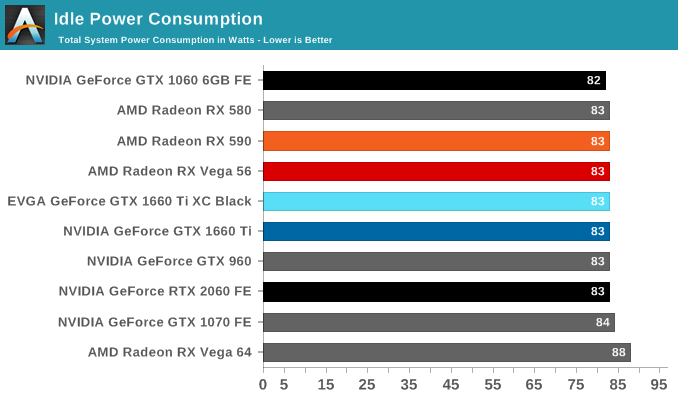

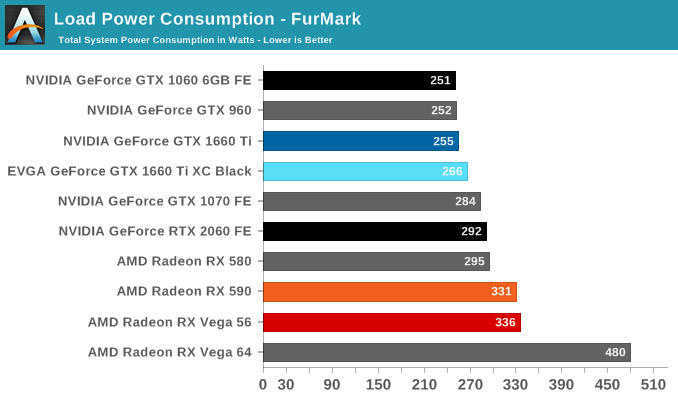
Even though NVIDIA's video card prices for the xx60 cards have drifted up over the years, the same cannot be said for their power consumption. NVIDIA has set the reference specs for the card at 120W, and relative to their other cards this is exactly what we see. Looking at FurMark, our favorite pathological workload that's guaranteed to bring a video card to its maximum TDP, the GTX 960, GTX 1060, and GTX 1660 are all within 4 Watts of each other, exactly what we'd expect to see from the trio of 120W cards. It's only in Battlefield 1 do these cards pull apart in terms of total system load, and this is due to the greater CPU workload from the higher framerates afforded by the GTX 1660 Ti, rather than a difference at the card level itself.
Meanwhile when it comes to idle power consumption, the GTX 1660 Ti falls in line with everything else at 83W. With contemporary desktop cards, idle power has reached the point where nothing short of low-level testing can expose what these cards are drawing.
As for the EVGA card in its natural state, we see it draw almost 10W more on the dot. I'm actually a bit surprised to see this under Battlefield 1 as well since the framerate difference between it and the reference-clocked card is barely 1%, but as higher clockspeeds get increasingly expensive in terms of power consumption, it's not far-fetched to see a small power difference translate into an even smaller performance difference.
All told, NVIDIA has very good and very consistent power control here. and it remains one of their key advantages over AMD, and key strengths in keeping their OEM customers happy.
Temperature
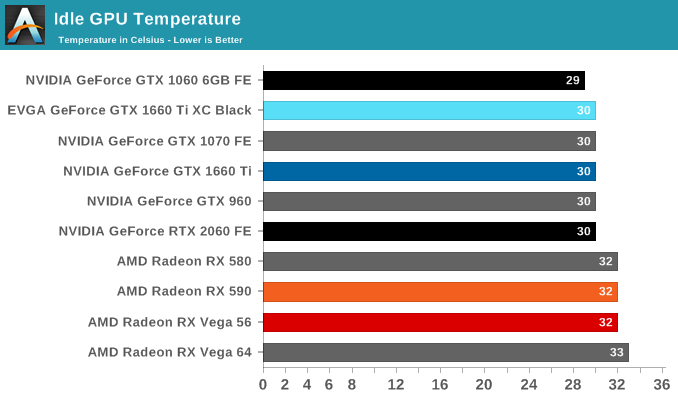
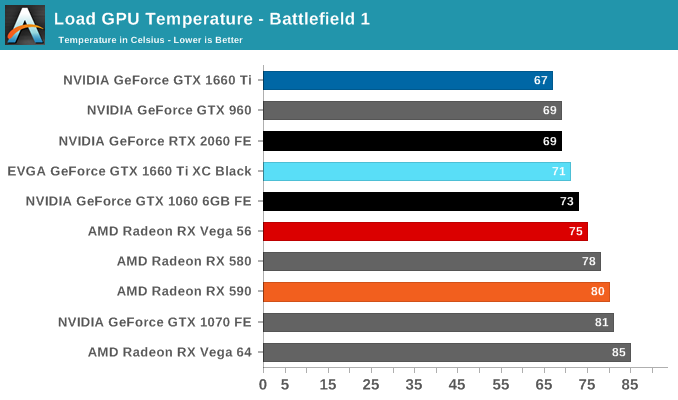

Looking at temperatures, there are no big surprises here. EVGA seems to have tuned their card for high performance cooling, and as a result the large, 2.75-slot card reports some of the lowest numbers in our charts, including a 67C under FurMark when the card is capped at the reference spec GTX 1660 Ti's 120W limit.
Noise

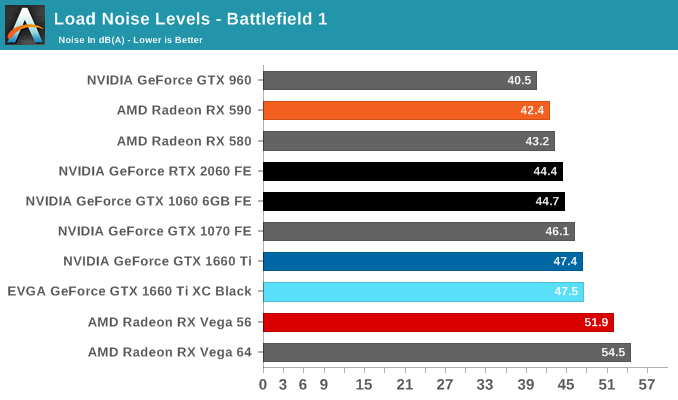

Turning again to EVGA's card, despite being a custom open air design, the GTX 1660 Ti XC Black doesn't come with 0db idle capabilties and features a single smaller but higher-RPM fan. The default fan curve puts the minimum at 33%, which is indicative that EVGA has tuned the card for cooling over acoustics. That's not an unreasonable tradeoff to make, but it's something I'd consider more appropriate for a factory overclocked card. For their reference-clocked XC card, EVGA could have very well gone with a less aggressive fan curve and still have easily maintained sub-80C temperatures while reducing their noise levels as well.










157 Comments
View All Comments
Korguz - Tuesday, March 5, 2019 - link
and again.. WHERE do you get your info from ??they can remove parts of IC's, or disable them, have you not been reading the articles on here about the disabled IGPs in intels cpus, but still charging the SAME price as the fully enabled ones ?
you refuse post links, OR mention your sources, simply because YOU DONT HAVE ANY.. IMO.. most of what you most.. is probable made up, or rumor, if AT posted things like you do, with no sources, you probably would be all over them asking for links, proof and the like... and by YOUR previous posts, all of your info is made up and false..
there is no point talking to a CHILD any more... when are you going to resort to name calling and insults again ?
Hrel - Friday, March 1, 2019 - link
Last page, I don't think comparing the 1660ti to the 1060 6Gb is appropriate, either the 3GB or 1050Ti. Comparing it to the 1060 makes it look like Nivdia isn't raising prices as much as they really are.I'm basically out of the GPU market unless and until pricing changes. Not that any good games have come out in the last few years, or are scheduled to. But I should be able to run 3 monitors at 1080p with 60fps minimum in any modern game for $200. Based on the numbers here, I don't think this $300 1660Ti could even do that, and we're already over the threshold by $100.
You are right about not caring about RTX. Basically the timing was just really bad for it, global economy is in contraction. Moore's law is dead, I guess that's why they're trying some other form of value add, but charging consumers isn't the way to do it. Labor participation rate is barely above 60%, over 1/3rd of the country is unemployed. Wages have stagnated for 70 years! We don't have any more to give!
crazyforsurprise - Wednesday, March 6, 2019 - link
<a href="https://www.crazyforsurprise.com/nvidia-gtx-1660-t... review </a>Questor - Wednesday, March 6, 2019 - link
Does anyone think EVGA could add just a bit more depth to that card? What is it? A 3 slot? At least 2.5. It's either a portable furnace or idiotic overkill.zazzn - Friday, April 19, 2019 - link
Why is PUBG never tested as one of the test games? It's notoriously badly optimized showing true raw performance?rothayato - Monday, August 5, 2019 - link
As a SFFPC (mITX) user, I'm enjoying the thicker, but shorter, card as it makes for easier packaging.Additionally, I'm enjoying the performance of a 1070 at reduced power consumption (20-30w) and therefore noise and heat! https://rottenhayato.com/_udata/gsnn/tenor-369.gif
bobhumplick - Tuesday, August 20, 2019 - link
if somebody hasnt upgraded in a while (9 series or older or 300 series or older for amd) then one of these cards is ok. not great but adequate. if you can last with what you have or if you would be happy with used or a refurb then go that route or wait for real nextgen(zotac has refurbed 1070 tis for 269 and they overclock to 1080 level performance).nvidia wanted to put these on 7nm or at least 10nm. 10nm isnt worth it in terms of performance and density (its more of a cell phone node) and 7nm needs EUV ot make large dies. its the waiting game. once EUV comes (if it does) the we will see a spurt of card gens coming quicker like they used to and then another slow down after about 5nm maybe